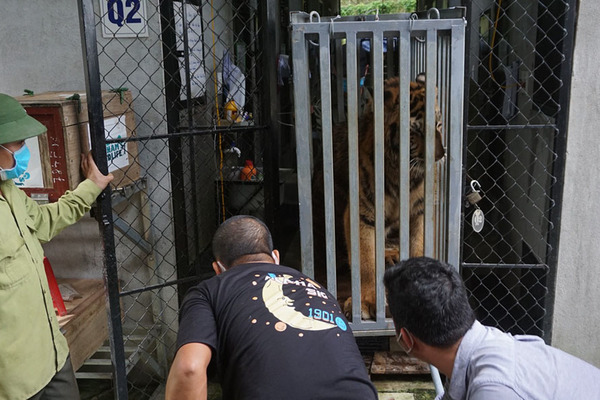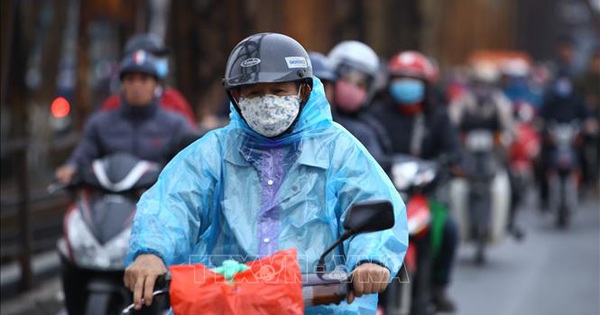The profession of climbing jaggery in the remote region
An GiangMr. Nguyen Ba Loc climbed about 60 jaggery trees twice a day, at most he obtained 800 liters of honey, pocketing nearly two million dong.
At 4 a.m., a man from An Phu, Tinh Bien district, left home, on his motorbike were four 30-liter plastic cans, more than 10 small bottles to store nectar. Going about 2 km, the field of jaggery appears, the root is as big as a person’s hug, towering. Stopping Mr. Loc’s car, he put a small flashlight on his head, dangling a bunch of plastic bottles from his belt, and approached the row of jaggery.
The tanned hands of the man U50 cling firmly to the homemade ladder (made of old bamboo with eyes intact, tied tightly to the palm trunk). Two strong legs, he climbed briskly up the tree. On the top of a tree about 20 meters above the ground, he chose a sturdy tree, then leaned on it, and began to collect honey.

Mr. Loc hangs himself on the top of a tree to get jaggery juice. Image: Ngoc Tai
Between the trees near each other, Mr. Loc built a monkey bridge (a type of bridge common in the West) made of bamboo, with handrails to move back and forth. Jasmine flowers bloom in clusters (bundles), 15-20 flowers, cylindrical, about the size of a wrist, about 30 cm long. In each box, Mr. Loc chooses 1-2 flowers, hangs the vase below to catch the water with sweet taste, faint fragrance, milky white color like boiled rice water.
Mr. Loc replaced the full water bottle with a new one and then dropped the bottles on the ground. When finished, he chose a flower that had just bloomed, using two bamboo sticks to gently clamp it from beginning to end like a massage movement. The stage is to stimulate flowers quickly for honey, usually after 4-5 days, there will be results.
Next, he used a knife to remove the outermost layer, cut the flower head and had to do it twice a day, otherwise they would heal and stop giving water. The final stage is to use the honeypot. On average, each flower gives three liters of water a day and lasts 1-3 months, depending on the age of the plant.
Burning notes for honey from the 7th lunar month to the next May. If it rains a lot, the tree can collect honey all year round. Because he was not in the business, he only got 4-5 cans of honey per meal. With the amount of water collected, Mr. Loc’s wife can cook more than 10 kg of jaggery, the selling price fluctuates from 20,000 to 26,000 VND per kg, earning more than 200,000 VND per day.
After the New Year, the tree gives a lot of water, increasing 6-7 times. With 60 jaggery trees left by his father, the man in the remote region collected 800 liters of honey, pocketing two million dong. But the profession is not afraid of the hot sun, only afraid of high winds and heavy rain, so many days he and his wife do not have any money.

Mr. Bang uses a bamboo stick to massage jaggery flowers, the first stage of the honey collection cycle. Image: Ngoc Tai
The area of Phu Nhut hamlet, An Phu commune, where Mr. Loc practiced, concentrated hundreds of palm trees. They are grown on dykes along rice fields or cassava fields. Mr. Le Thanh Bang, who owns more than 50 jaggery trees here, said that although he did not number or mark the tree, someone’s tree would climb without dispute or argument.
According to those who have seniority in climbing jaggery, although there is no job group, anyone who follows the profession must be a little spiritual. At the beginning of the year, they often set up an offering tray at the land or practice, richly offer a pair of ducks, narrowly offer tea and fruit, and pray to Mr. Ta (a spirit of folk beliefs) to protect his hands and eyes. accident.
Although the work is hard and dangerous, the people in the profession are also very happy. At the peak of the harvest, the brothers hung on the treetops until 10 o’clock at night. They went to work together, the whole group talked to each other when they were in the middle of the sky. Neighborhood stories and village stories help them dispel the hardships and emptiness of the night. When it was late at night, the whole group returned together, often staying alone in the middle of nowhere.
On crowded tourist occasions, guides bring guests to watch them climb. Having the opportunity to talk about the profession, seeing tourists with wide eyes and flat eyes surprised, they take it as joy. Customers come back to buy more golden sugar glue and jaggery chips as gifts. The market for specialties in the remote regions has thus expanded, leading to a stable income for climbers.

The jaggery juice taken down will be put into each 30-liter can and then taken home. Water used for drinking or cooking sugar. Image: Ngoc Tai
Nodules are monoecious, male and female plants separate. Both types give the same amount of water. The owner often leaves the female flower to sell fruit because when taking nectar, the flower will not give fruit. On average, 8 liters of honey will cook 1 kg of jaggery. A mature tree gives about 100 kg of sugar per year. The tree grows naturally without needing to be cared for or watered, so the people who climb the jaggery mainly take the work as a profit.
The symbolic tree of the remote An Giang region, when grown up to 30 m high, the lifespan is over 100 years. The tree is drought tolerant, waterlogged, sunny but not cold. Young plants grow slowly at first, then grow faster. It takes more than 30 years for the tree to bear fruit, so the locals often compare it to “the tree that grandson planted and enjoyed”.
In addition to nectar, fruit for food, the trunk can be used as building materials, handicrafts, and leaves are used as fuel. In Tri Ton and Tinh Bien districts, there are nearly 70,000 jaggery trees, each year harvesting about 8,000 tons of sugar.
Fields in An Giang grow many palm trees interspersed with rice fields and cassava fields. Video: Ngoc Tai
Ngoc Tai
at Blogtuan.info – Source: vnexpress.net – Read the original article here




